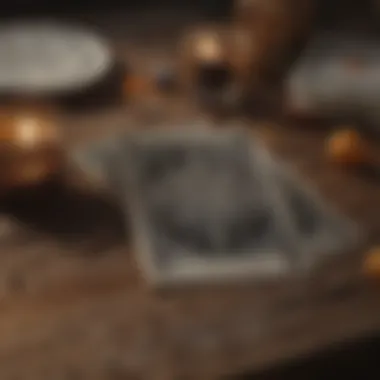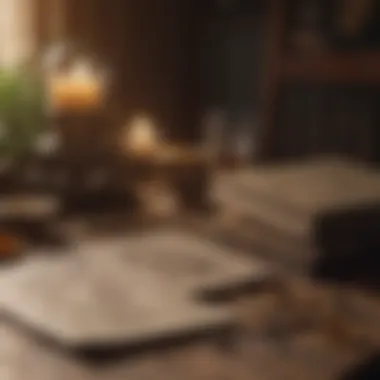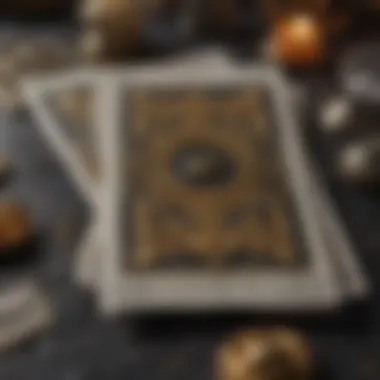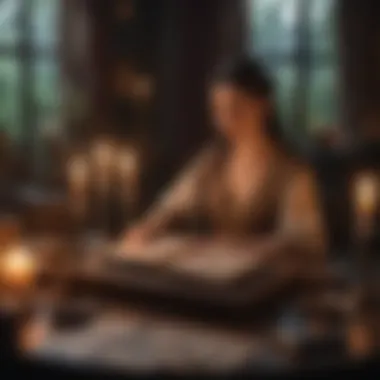The Impact of Questions on Tarot Reading Insights


Intro
Tarot readings serve as a nuanced dialogue between the reader and the cards, influenced heavily by the questions posed. The efficacy of a reading often hinges on the clarity and intention behind these questions. Unlike mere fortune-telling, tarot invites exploration, reflection, and insight, making the construction of queries essential.
In this article, we will navigate the role of questions in tarot readings, focusing on how different types of questions can shape interpretations. The structure of these inquiries can lead to profound revelations or merely surface-level understanding. By emphasizing thoughtful question formulation, we aim to enrich both novices and experienced practitioners' engagements with their tarot practices. This guide provides practical advice while shedding light on common pitfalls that may hinder one's tarot journey.
Understanding the diverse impact of questions reveals not only the art of tarot reading but also the complexities behind human cognition and perception. By learning to ask the right questions, individuals can open doors to deeper connections and insights, enhancing their experiential knowledge of the tarot.
Foreword to Tarot and Its Interpretative Nature
Tarot is far more than a simple deck of cards. It represents a profound art form rooted in history, culture, and psychology. Understanding the interpretative nature of Tarot is essential for anyone engaging with it, whether professionally or personally. This introduction serves as a foundation for comprehending how questions shape our Tarot experiences.
The interpretative function of Tarot lies in its ability to reflect the reader's and querent's thoughts, emotions, and situations. Each draw is a moment of insight, inviting both the reader and the seeker to engage deeply with the imagery and the symbolism inherent in each card. Notably, the way questions are framed and approached can greatly influence the outcomes of a reading. Hence, the interaction between the question and the cards must be emphasized.
Importance of Questions
The significance of questions in tarot readings cannot be understated. Just as a sculptor carefully selects their tools, a Tarot reader must refine their inquiries to facilitate meaningful interpretations. A good question serves not only as a focal point but also as a channel through which clarity can manifest. In this regard, questions that are open-ended can evoke broader reflections, while specific inquiries can guide the interpretation towards concise answers.
When one approaches a Tarot reading with intention, the dialogue between the question and the cards creates a deeper resonance. Each card drawn becomes a mirror, reflecting possible paths, hidden fears, and unarticulated desires. In this way, a Tarot reading transcends mere fortune-telling and evolves into a psychological exploration.
Furthermore, the intrinsic nature of questions aligns closely with the principles of human cognition. They are not only queries; they are gateways to understanding complex emotional landscapes. This practice becomes a journey—one where the seeker navigates through insights, revelations, and, often, self-discovery.
In the following sections, we shall delve into the multifaceted relationship between Tarot and questions. We will explore how different types of questions can lead to varied interpretative avenues. Thus, crafting appropriate, precise questions becomes a pivotal skill for any tarot practitioner aimed at achieving deeper connections with their tarot experiences.
Understanding Tarot: A Brief Overview
Understanding Tarot is fundamental in grasping how questions play a vital role in readings. Tarot is not merely a tool for fortune-telling; it is a complex interpretative system crafted from centuries of history and cultural significance. The insights garnered from a Tarot reading hinge significantly on the questions posed by the querent, which dictates the direction and focus of the reading. By comprehending the fundamental aspects of Tarot, practitioners can enhance their reading capabilities and foster deeper connections with the intuitive process.
History of Tarot
The journey of Tarot begins in the 15th century in Europe, where it started as a card game rather than a mystical tool. The early Tarot decks, such as the Visconti-Sforza deck, primarily featured cards for play. However, by the late 18th century, the perception of Tarot shifted, marked by the publication of Antoine Court de Gébelin's work, which laid the groundwork for tarot as a method of divination.
Since then, different schools of thought have shaped Tarot's evolution, including the Kabbalistic approach and the Golden Dawn’s esoteric teachings. In contemporary times, the Tarot community continues to grow, with many practitioners finding personal meaning in its rich symbolism and diverse decks.
The Structure of a Tarot Deck
A traditional Tarot deck consists of 78 cards categorized into two main sections: the Major Arcana and the Minor Arcana. The Major Arcana includes 22 cards, such as The Fool and The Lovers, which symbolize significant life themes and spiritual lessons.
On the other hand, the Minor Arcana comprises 56 cards divided into four suits: Wands, Cups, Swords, and Pentacles. Each suit represents different aspects of life, with Wands related to inspiration, Cups to emotions, Swords to thoughts, and Pentacles to material matters. Understanding this structure is crucial, as it aids in interpreting the nuances of the cards in context to the questions asked during a reading.
Symbolism and Meanings of the Cards
Each Tarot card is rich in symbolism, holding multiple layers of meaning. For instance, The Tower signifies sudden upheaval and transformation, while The Empress embodies fertility and abundance.
The interpretations of these cards can vary significantly depending on the question posed. When a querent asks about personal growth, The Empress’ nurturing aspect may be seen as an invitation to embrace creativity. Conversely, asking about challenges may highlight the disruptive nature of The Tower. Understanding these symbolic meanings allows practitioners to extract deeper insights when interpreting the cards based on the querent's questions, providing a more nuanced reading experience.
The significance of questions in Tarot readings cannot be overstated; they serve as the compass guiding the interpretation of the cards toward meaningful insights.
The Importance of Questions in Tarot
In tarot reading, the significance of questions cannot be overstated. Questions act as a guiding force, shaping the reading, and influencing the interpretations of the tarot cards. A well-formed question amplifies the potential of the reading by clearing the path for insightful revelations. Conversely, poorly framed or vague questions can lead to confusion and misinterpretation of the cards' messages.
The primary benefit of asking the right questions lies in the clarity they provide. Specific inquiries help focus the reader's energy and intention. This focus is essential because tarot is not merely about the cards themselves, but about the meaning derived from them in the context of the question. For instance, instead of asking, "What will my future be like?" a more targeted approach would be, "What do I need to know about my career path in the coming year?" This refinement in questioning leads to more precise insights.


Considerations about the importance of questions in tarot readings also involve the psychological aspects of inquiry. The act of posing a question reflects the querent's state of mind and their desires for understanding. It reveals what they think is important or what is currently troubling them. In this sense, questions can act as a mirror to the querent’s inner self.
Another significant factor is the type of relationship that exists between the reader and the querent. When the reader understands a querent's needs and interests, the effectiveness of the questions improves. This rapport can enhance the reading by creating a more open dialogue, allowing for deeper exploration of the issues at hand.
Questions form the very basis of inquiry in tarot practice. They not only determine the direction of the reading but also serve as catalysts for personal development and reflection. Whether one is a novice or a seasoned practitioner, the art of questioning is fundamental in unlocking the true potential of a tarot reading. As such, cultivating the skill of formulating insightful questions is essential for anyone looking to delve deeply into the tarot's rich tapestry of meanings.
"The quality of a tarot reading is often directly proportional to the quality of the questions asked."
In summary, understanding the importance of questions in tarot will elevate the reading experience for both the reader and querent. Insightful questions lead to refined interpretations, enhance personal introspection, and build a constructive relationship between the reader and the querent.
Types of Questions to Ask
In the realm of Tarot readings, the formulation of questions is paramount. The type of question posed can significantly influence the quality and depth of insights received. Understanding various question types helps practitioners optimize their readings. This section explores the different categories of questions and their strategic benefits.
Open-Ended vs. Closed Questions
Open-ended questions encourage expansive exploration. They invite detailed responses and deeper reflections. For instance, instead of asking, "Will I get the job?" one could ask, "What steps can I take to enhance my chances of securing this job?" This shift not only facilitates a richer dialogue with the cards but also promotes personal agency.
Closed questions, on the other hand, typically lead to binary answers like yes or no. While these questions can be useful, they often limit the scope of the reading. An example would be, "Should I go on this trip?" This question narrows the outcome, depriving the querent of broader insights. Balancing between open-ended and closed questions is crucial for effective readings.
Situational Questions
Situational questions are tailored to specific contexts, allowing for a clear assessment of a situation. Inquiries such as "What should I focus on in my current relationship?" or "How can I address the challenges at work?" foster clarity. These prompts help clarify the nuances of the situation at hand, guiding the reader toward practical solutions.
These types of questions should be precise, as vagueness can yield unclear responses. Identifying the distinct aspects of a current situation makes it easier for the cards to reveal insights tailored to that context. This way, the readings become more applicable and relevant.
Personal Development Questions
Questions focused on personal development encourage self-reflection and growth. They might include, "What can I do to improve my emotional well-being?" or "How can I embrace my creativity?" Such inquiries foster a transformative reading experience. They not only provide guidance on challenges but also open paths for growth.
Personal development questions often lead the querent to discover hidden strengths or resources. These revelations are crucial for profound self-awareness. They illuminate paths the querent may have overlooked, encouraging holistic development.
By mastering the art of question formulation, practitioners can elevate their Tarot readings. Recognizing the difference between question types enhances the interpretative capacity of the cards. As each question type serves a distinct purpose, the practitioner’s intent should align harmoniously with the chosen format.
Crafting Effective Questions
Crafting effective questions lies at the heart of meaningful tarot readings. It determines not only the clarity of the inquiry but also the depth of insight that can be extracted from the cards. A well-formed question can guide the tarot reader towards relevant interpretations, unlocking the potential of the cards to reveal hidden knowledge and truths. This section will explore specific elements that make a question effective, the benefits of thoughtful questioning, and key considerations when formulating inquiries.
Clarity in Purpose
Clarity in purpose is essential when formulating tarot questions. A question that is vague or muddled can lead to confusion in the reading, obscuring the intended message of the cards. To ensure clarity, practitioners should identify their primary objective before asking the question. This involves reflecting on what one hopes to achieve from the reading. Is it advice for a personal issue, insight into relationships, or guidance for future decisions? A clear purpose provides a foundation for precision, allowing the reader to connect deeply with the drawn cards.
Focus on Intent
When one focuses on intent, the question takes on a more directed and powerful form. Intent refers to the underlying motivation behind the inquiry. It is essential to approach the tarot reading with a mindset that prioritizes personal growth and understanding. Questions framed with specific intent—rather than general curiosity—tend to yield more informative responses. For instance, instead of asking, "What will happen in my life?" one might ask, "What can I do to improve my career path at this time?" This shift in wording reflects an intention to seek actionable insights rather than passive predictions.
Language and Framing Concerns
The language used in questions can profoundly impact the outcome of the tarot reading. Poorly framed questions may lead to ambiguous answers that do not provide clear guidance. Practitioners should be mindful of the words they choose. Questions framed in positive language are often more effective, as they encourage constructive responses from the cards. For example, rather than asking, "Why do I always fail?" one could rephrase this as, "What steps can I take to overcome my challenges?" This positive framing aligns the inquiry with solutions instead of problems, enhancing the likelihood of receiving beneficial insights.
Effective questions are not merely about seeking answers but are also about guiding the tarot reading towards clarity and purpose.
In summary, crafting effective questions is a skill that enhances the tarot reading experience. By ensuring clarity in purpose, focusing on intent, and being cautious with language, practitioners can create inquiries that resonate with the cards and provide valuable guidance.


Interpreting Tarot Responses to Questions
Interpreting Tarot responses to questions involves a deeper engagement with the cards. This segment emphasizes how the nature of the response can influence the querent's understanding of their situation. A tarot reading is not merely about the cards drawn but rather how these cards relate to the inquiries made. The process of interpretation is essential in uncovering insights and providing guidance.
Understanding the nuances of the readings helps practitioners to connect with the querent. Rather than seeing the tarot as a fixed answer, viewing it as a dialogue fosters exploration. Interpretation requires a balance between the symbolism of the cards and the context of the question. When done effectively, the insights gleaned can lead to transformative realizations.
Contextual Analysis
Contextual analysis in tarot reading is about understanding the larger scenario surrounding a question. It involves considering personal circumstances, emotions, and even external factors that may affect the querent's situation. The advice offered by tarot cards is inherently influenced by these aspects. For instance, drawing the Tower card amidst questions about stability may signify impending change and upheaval. In another context, it may represent a necessary breakdown leading to growth.
When interpreting responses, a practitioner should take note of:
- The emotional state of the querent.
- Situational dynamics at play.
- Any ongoing relationships that may impact the inquiry.
By evaluating context, the cards reveal more meaningful insights. It allows the reader to provide tailored guidance. This stage enriches the tarot experience and enhances the relevance of the interpretation.
Seeking Patterns and Themes
Seeking patterns and themes in tarot responses adds another layer of depth. Patterns may emerge through repeated symbols, card combinations, or overall emotional tone in the reading. Regularly engaging with tarot can help a practitioner notice these recurring elements and themes in subject matter, such as love, career, or personal growth.
Recognizing themes can lead to better foresight for both the reader and the querent. For example, a series of readings may consistently present cards related to self-reflection. This could indicate that the querent should focus on their inner development before addressing external issues. It is crucial to be aware of:
- Recurring symbols over time.
- Repeated questions that suggest unresolved issues.
- Emotional trends in the querent’s responses and disposition.
"Consistency in responses is often a guide to unearthing deeper truths within the querent's journey."
By identifying these elements, the tarot reader can foster a deeper understanding of the querent's narrative. This ultimately enhances the overall efficacy of the tarot session, guiding the querent toward more profound personal insight.
Common Mistakes in Questioning
In tarot readings, the quality of the questions being asked significantly influences the results. Understanding the common mistakes in questioning is essential for anyone looking to derive meaningful insights from tarot. Misguided questions can lead to superficial interpretations, leaving the user without the clarity they seek. By avoiding these pitfalls, users can enhance their experiences and deepen their understanding of the cards.
Asking Yes or No Questions
One of the most prevalent mistakes in tarot questioning is the inclination to ask yes or no questions. These questions often oversimplify complex situations. For instance, asking "Will I get that job?" fails to capture the nuances surrounding the job application, such as the skills the asker brings or the workplace environment.
Yes or no questions limit the depth of exploration available during a tarot reading. Instead of seeking a binary answer, users should reframe their queries to invite a broader perspective. For example, a more insightful question could be, "What factors should I consider regarding this job opportunity?" This approach fosters a richer dialogue with the tarot, leading to more valuable insights and understanding.
Leading Questions
Another common issue is the use of leading questions. These queries guide the tarot reader toward a specific answer, often reflecting the asker's biases or desires. A question like, "Why is this person being so difficult with me?" suggests a negative perspective without allowing for other interpretations.
Leading questions can obstruct the clarity needed for a productive reading. They can create an echo chamber effect, where the user only sees what they want to see instead of receiving a balanced interpretation. To mitigate this mistake, it's advisable to ask open-ended questions. For instance, asking "What should I understand about my relationship with this person?" encourages a broader exploration of the situation, enabling the tarot cards to reveal insights that might otherwise be overlooked.
By avoiding these common mistakes in questioning, tarot practitioners can unlock the full potential of their readings, providing a platform for growth and deeper self-awareness.
The Role of Intuition in Formulating Questions
In the realm of tarot, intuition plays a pivotal role in creating questions that resonate with deeper truths. The process of asking questions should not be merely academic; it ought to stem from an inner feeling or a gut instinct. Many find that when they tap into their intuitive faculties, they can frame inquiries that lead to richer and more meaningful responses from the cards.
Embracing intuition involves recognizing the subtle cues that arise within oneself. Often, these cues inform the heart and soul of the questions posed during a tarot reading, enhancing the interpretative experience. When a practitioner aligns their queries with their intuitive insights, they invite a greater depth into their readings.
Tapping into Higher Awareness


To tap into higher awareness is to cultivate a state of being where insights and wisdom flow more freely. This state is often accessed through meditation or mindfulness practices. Practitioners can benefit from dedicating time to quiet their minds.
By doing this, the clarity of vision increases. Some find that journal writing can also serve as a conduit to this heightened awareness. Asking open-ended questions about their life experiences in a journal allows them to explore their thoughts and feelings without restraint.
When they subsequently approach tarot readings, they can rely on the knowledge gained through contemplation. This practice allows the formulation of questions that reflect both the practical and the spiritual dimensions of their inquiries, leading to a more profound understanding.
Listening to Inner Guidance
Listening to inner guidance requires a willingness to trust oneself. Many tarot practitioners struggle with this; however, it is essential for effective questioning. Inner guidance often manifests as a quiet voice or an emotional response concerning what feels right in a given context.
Practicing active listening to this inner voice can significantly enhance question formulation.
- Be present: Enjoying the moment and being aware of surroundings can help bring clarity.
- Acknowledge the feelings: Emotions that arise when contemplating a question should not be overlooked. They can reveal what truly matters.
- Embrace vulnerability: Understanding personal fears and desires enables a stronger rapport with personal truths.
All these components work collectively to refine the questioning process. When practitioners heed their inner guidance, they ask questions that not only reflect surface interests but also connect to deeper issues that might be warranting exploration.
Ultimately, the marriage of intuition with a structured approach in formulating questions yields significant benefits for tarot readings. By fostering intuition, practitioners create a dynamic space for genuine exploration of life's complexities.
Practical Exercises for Improving Questioning Skills
Enhancing the skill of crafting questions is essential for a successful tarot reading. Practical exercises allow tarot readers to refine their questioning techniques. The intention behind questions greatly influences the interpretation of cards. By engaging in specific activities, readers can learn how to formulate inquiries that lead to more profound insights.
Practicing these exercises helps in several ways. Readers develop better clarity in what they seek to learn. They also learn to recognize the nuances of their own thought process. These insights can lead to more meaningful tarot sessions. Moreover, consistent practice encourages confidence in questioning.
Journaling Questions
Journaling is a powerful tool for improving questioning skills. By keeping a dedicated journal, readers can record their thoughts and questions before and after tarot readings. This practice fosters self-reflection and clarity.
Consider these aspects when journaling:
- Identify Themes: Write down recurring thoughts or themes in your tarot practice.
- Formulate Questions: Create questions based on initial reflections. This encourages deeper analysis of concerns.
- Track Outcomes: After readings, document the responses to your questions and your reflections on them.
Reflecting on these elements can enhance one’s ability to develop questions that resonate with personal inquiries. It also aids in observing any patterns that may emerge over time.
Mock Readings with Peers
Mock readings serve as an excellent way to practice questioning skills in a supportive environment. Engaging with peers enhances the learning experience. Participants can generate diverse questions and interpretations. This variety brings new perspectives into the art of questioning.
When conducting mock readings, consider these steps:
- Choose a Focus: Each participant selects a specific area to explore.
- Prepare Questions: Write down questions in advance, using insights gained from journaling.
- Conduct Readings: After drawing the cards, discuss interpretations as a group.
- Feedback Loop: Share constructive feedback on the effectiveness of each question.
Through this process, not only do participants strengthen their skills, but they also build a community around learning. This collaborative approach brings various insights, making every session richer.
Further exploration of questioning in tarot can yield profound growth and understanding. Regular practice of these exercises will surely enhance the quality of tarot readings.
End: Embracing the Art of Questioning in Tarot
The role of questioning in tarot readings is essential for obtaining meaningful insights. The right questions not only direct the reading but also enhance the interpretative process. Each question sets the stage for the narrative that emerges from the cards. Thus, the conclusion emphasizes that the craft of questioning demands attention and intent.
As discussed in the article, effective questions hold the power to shape the outcome of a reading. These inquiries drive the practitioner to connect more deeply with the querent's situation. A thoughtful approach encourages a dialogue between the individual and the cards, where the intent can reveal deeper layers of understanding.
Understanding various forms of questions, such as open-ended versus closed, helps to draw out richer insights. Practitioners should always aim for clarity, remembering that vague questions yield unclear responses. This practice not only sharpens the reading but also cultivates a greater awareness of one's intent.
Furthermore, avoiding common pitfalls in questioning can shield one from misleading interpretations. For instance, steering clear of leading questions preserves the integrity of the reading. The goal is to foster an environment of exploration, where both reader and querent can engage with the information authentically.
Benefits of Embracing Artful Questioning:
- Enhances customer engagement and personal exploration.
- Encourages clarity in understanding situations.
- Helps build a structured and reflective practice.







